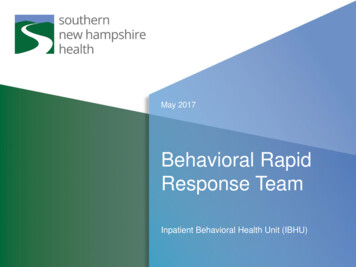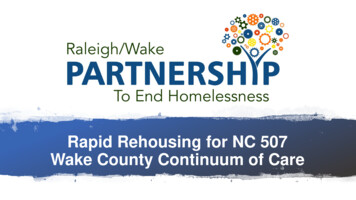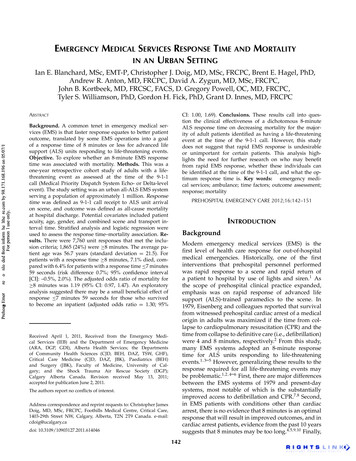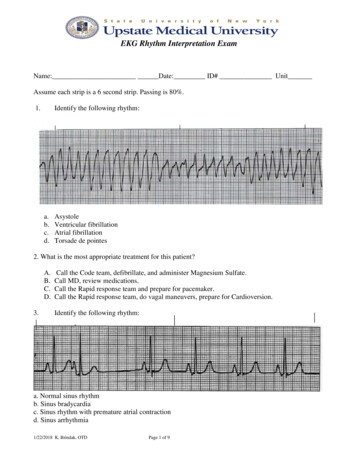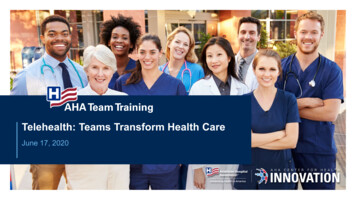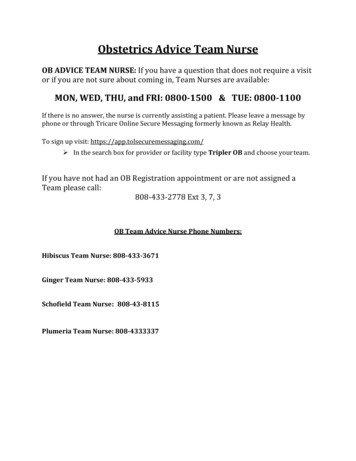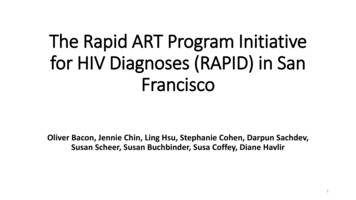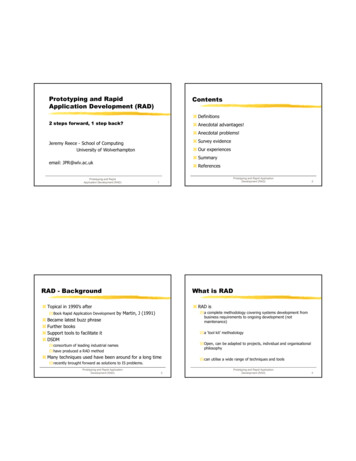
Transcription
Virginia Rapid Response TeamOur Mission:The Virginia Rapid Response Team’s mission is to provide a rapid unifiedmultiagency all hazards response to food/feed emergencies in order tominimize the social, economic and public health impact.History:In October 2009, the VDACS Food Safety Program was one of three statesawarded a 3-year cooperative agreement from FDA to develop and sustainan all Food Hazards Rapid Response Team (RRT), encompassing bothfood and feed protection programs, through a process to further enhanceand build the infrastructure of the State’s food protection program. Thedesired outcome of RRT development is to minimize the time betweenagency notification of a human or animal food contamination event andimplementation of effective control measures. To accomplish this, RRTsdevelop and maintain processes to: Prepare for and effectively respond to foodborne illness outbreaksand other food emergencies. Enhance intra-agency and interagency collaboration andcommunication. Jointly train and exercise staff to be ready to respond to events whenthey occur. Identify potential preventive practices to reduce foodborne illness andinjury.
Establish national best practices and tools that can be shared withother states to improve their response to food emergencies. RRT’s operate using Incident Command System (ICS)/NationalIncident Management System (NIMS) principles and a UnifiedCommand structure to respond to human andanimal food emergencies.For more information on Rapid Response Teams (RRTs), please visitFDA’s RRT website.Membership: Virginia Department of Agriculture and Consumer Services Food Safety Program Dairy Services Program Agricultural Commodities Program Office of Meat and Poultry Services Virginia Department of Health Office of Epidemiology Office of Environmental Health Office of Shellfish Sanitation Division of Consolidated Laboratory Services U.S. Food and Drug Administration Baltimore District Office United States Department of Agriculture Food Safety Inspection Service
Response:Rapid Response Teams (RRTs) responses and activations show howstrengthened collaboration and capabilities can have a meaningful impacton the efficiency and effectiveness of a response.Emergency response:Through training, such as FDA coursework and table-top exercises, theVirginia RRT is prepared to respond to emergency events when they occur.Below are examples of responses the VA RRT has participated in: Collaborates in foodborne illness investigationsDetermines the safety of food products after vehicular accidentsResponds to reports of employee illness at food establishmentsInvestigates reports of illegally processed foods offered for saleAssesses the damage of foods in firms that manufacture, distribute orsell foods after disasters, such as fires, floods and emergencyweather eventsAdditionally, the Virginia Rapid Response Team Members are trained toserve in the Emergency Operation Center during declared disastersituations.Recalls:Food producers recall their products from the marketplace when theproducts are mislabeled or when the food may present a health hazard toconsumers, such as a potential contamination or has caused a foodborneillness outbreak. Visit FDA's Recalls, Market Withdrawals & Safety Alertssection to view recent recall information by product area, including food,drugs, biological products, devices, and cosmetics.The U.S. Department of Agriculture (USDA) regulates beef, poultry, andprocessed egg products. Please visit FoodSafety.gov for food safety andrecall information from both FDA and USDA.
Foodborne Outbreaks & Illnesses:While the American food supply is among the safest in the world, theFederal government estimates that there are about 48 million cases offoodborne illness annually which is equivalent to sickening 1 in 6Americans each year. Each year these illnesses result in an estimated128,000 hospitalizations and 3,000 deaths.Did you know that Food Borne Illnesses are usually not from food youconsumed just before you became Ill? Please visit the following links tolearn more about Food Borne Illnesses: Foodborne Illnesses: What You Need to Know Bad Bug Book (Second Edition)If you wish to submit a complaint concerning a foodborne illness, orconditions at a food manufacturer or retail store, please report it here.Virginia Food Protection Task Force:The Virginia Food Protection Task Force (VA FPTF) is a diverse group ofprofessionals with government, industry, retail and academic affiliations.Their mission is “to serve Virginia by identifying and addressing fooddefense and food safety issues pertinent to the Commonwealth throughstakeholder collaboration, communication, education and cooperation”. Ifyou have any interest in becoming a part of the VA FPTF, please contactLauren Turner. The VA FPTF Executive Board is planning activities that areintended to engage members, provide avenues for participation in differentinitiatives, and encourage members to provide expertise in various foodprotection topics. Please visit here to sign-up for the quarterly newsletterand for updates on current activities.
Updates:The VA RRT has coordinated response, deployed investigators, sampledproducts and educated food handlers during several large foodborne illnessoutbreaks throughout the Commonwealth. The RRT has also coordinatedsurveillance and investigation sampling of high-risk foods for pathogens inorder to protect public health. All sample results are entered into a nationaldatabase in order to strengthen outbreak discovery and response.Additionally, the VA RRT has helped fund two innovative projects. The firstproject was a Pandora Radio Campaign Ad broadcasted to increase publicawareness of Hepatitis A (article included below). The second project, theMyMeal Detective, is a website consumers can access to submit reports offoodborne illness (article included below).Virginia Hepatitis A Pandora Radio Campaign A SuccessStory of Interagency CollaborationSeptember 13, 2019 3:34 PM by Amy Bonsell (Administrator)The Virginia Department of Health (VDH) Foodborne DiseaseEpidemiology Team (FDET), in coordination with the Virginia RapidResponse Team (RRT) and Virginia Food Protection Task Force, partneredwith Pandora Radio to develop a hepatitis A Pandora Radio Campaign thatwas broadcast in June of 2019. We developed three media images and a30-second script which the Pandora Creative Team recorded. Therecording and images were displayed when subscribers used or listened toPandora Radio. The campaign had over 1 million impressions, or ad views,during the month. Concurrently, VDH recorded an increase of 198.6%unique views of the public facing VDH hepatitis A virus (HAV) landing pageduring the Pandora Radio Campaign. Overall, the hepatitis A PandoraRadio Campaign was a great success in highlighting interagencycollaboration and increasing public awareness about HAV by providingeducation about how it is spread, signs and symptoms of infection, andhow to reduce the transmission to the general public.
Pandora Radio is a music and podcast streaming internet radio service. Asignificant portion of Pandora listeners use the ad-supported version ratherthan pay for a subscription. The Virginia hepatitis A Pandora RadioCampaign utilized two different product methods, Audio Everywhere Adsand Mobile Display Ads, in order to increase the campaign’s effectiveness.The Audio Everywhere product reached the target audience by weaving therecorded audio advertisement seamlessly into the listening experiencebetween songs and podcasts. The Mobile Display product worked bydisplaying a media image linked to a webpage when a listener interactswith their device, i.e.; adjusting the volume or skipping a song. The MobileDisplay is an attention getting image that draws listeners in and allowsthem to click on the advertisement for more information. There were over 1million impressions, or ad views, to the campaign during the month of June.The Audio Everywhere Ad was played over 695,000 times and the MobileDisplay Ad was displayed over 404,000 times.The different media images that were used for the campaign are shownbelow. Figures 1 and 2 were displayed when the Audio Everywheremessage played. Figure 3, with the poop emoji, was displayed using theMobile Display option which displays when a listener interacts with theirmobile device, such as when skipping a song or adjusting the volume.If you would like more information regarding the campaign or have anyquestions, please contact foodborneepi@vdh.virginia.gov.Submitted by :MaryBeth DeMarco, OutbreakNet Enhanced EpidemiologistDivision of Surveillance and Investigation Office of EpidemiologyVirginia Department of Health109 Governor Street, 5th Floor, Richmond, VA 23219
Virginia’s Foodborne Illness Reporting System - My MealDetectiveApril 19, 2019 2:04 PM Amy Bonsell (Administrator)The My Meal Detective (MMD) was created by the Virginia Department ofHealth (VDH) in 2016. MMD is a public-facing website, managed by a stateenvironmental health (EH) and epidemiology collaborative team, whereconsumers can easily report foodborne illness. The MMD survey form(housed on the VDH REDCap server) gathers demographic information,symptomology, and suspected source of illness from the complainant (i.e. athree-day food history). When a survey is submitted, the REDCap systemsends an email alert to the MMD inbox for triage by EH staff who forward itto the appropriate local health district and the Virginia Department ofAgriculture and Consumer Services (VDACS) Food Safety Program forfollow up. A campaign to advertise MMD began in 2018 to promote thewebsite through VDH social media and distribution of magnets with a QRcode and MMD logo.Since the creation of the MMD website in 2016, Virginia received over 900online complaints of illness. From March through December of 2018, 520illness complaints were received. Reports were received from complainantsresiding in twenty-one states and the District of Columbia. The majority ofillness complaints received were from those who dined at a Virginiarestaurant (N 438) followed by those who purchased food items fromgrocery or retail stores (N 46). MMD reports led to the identification of sixfoodborne outbreaks in 2018.Implementation of the MMD website has improved Virginia’s ability toreceive, analyze and respond to foodborne illness complaints and identifyfoodborne outbreaks. The continued promotion and advertising of MMDwill help raise awareness of the complaint system and educate Virginiaconsumers on the importance of food safety.
The Virginia Rapid Response Team (VA RRT) is a multi-agency responseteam composed of members from the Virginia Department of Agricultureand Consumer Services, Virginia Department of Health, Division ofConsolidated Laboratories (state public health lab), United StatesDepartment of Agriculture Food Safety Inspection System, and the Foodand Drug Administration Baltimore District Office Human and Animal Food2 East. The mission of the VA RRT is to provide a rapid and multi-agencyresponse to food and feed emergencies in order to minimize the social,economic and public health impact. The VA RRT works in cooperation toprovide prevention and educational materials to industry and consumers.Recently, the RRT has provided funding to print and distribute QR codemagnets to promote the My Meal Detective Direct Consumer ReportingWebsite.Funding for the VA RRT and educational materials was made possiblethrough Grant funding by the Federal Government, Food and DrugAdministration, Department of Health and Human Services.
Pandora Radio. The campaign had over 1 million impressions, or ad views, during the month. Concurrently, VDH recorded an increase of 198.6% unique views of the public facing VDH hepatitis A virus (HAV) landing page during the Pandora Radio Campaign. Overall, the hepatitis A Pandora Radio Campaign was a great success in highlighting interagency
